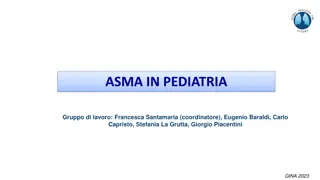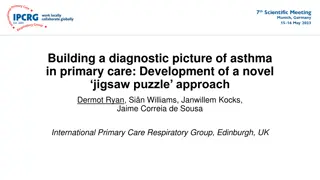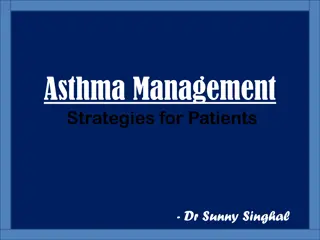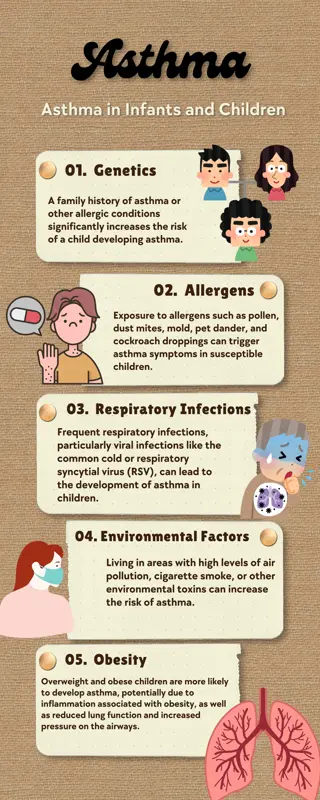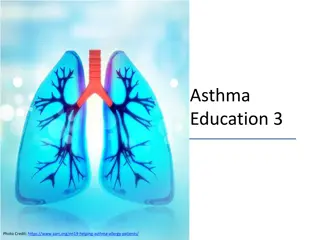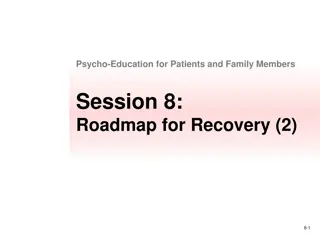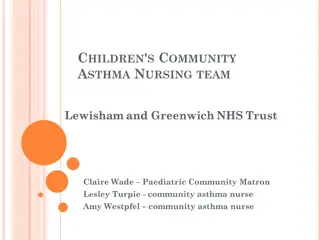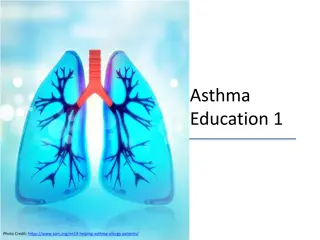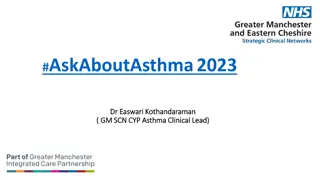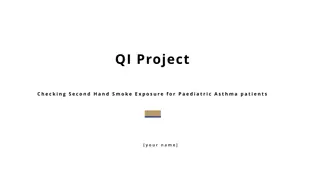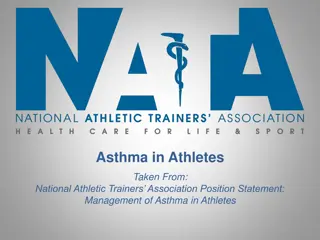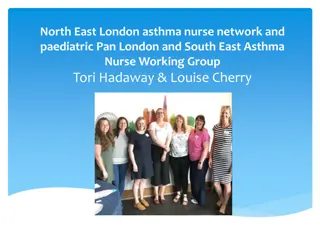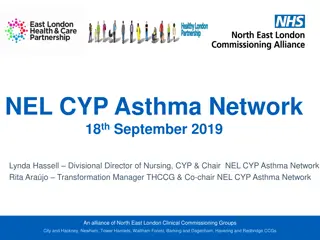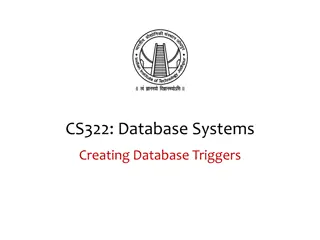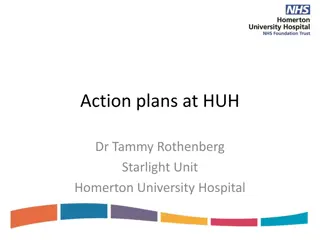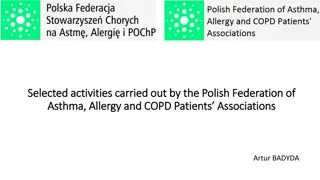Understanding Asthma: Symptoms, Triggers, and Management in Schools
Asthma is a common condition affecting many individuals, especially in school settings. This training aims to educate on recognizing asthma, providing support during attacks, available treatments, and school responsibilities. Asthma symptoms include coughing, wheezing, chest tightness, and shortness of breath. Allergic triggers like dust, pollen, and mold can worsen symptoms. Managing asthma involves monitoring symptoms, knowing when to use a reliever, and seeking help during severe attacks. By understanding asthma better, schools can create a safer environment for students with this condition.
Download Presentation

Please find below an Image/Link to download the presentation.
The content on the website is provided AS IS for your information and personal use only. It may not be sold, licensed, or shared on other websites without obtaining consent from the author. Download presentation by click this link. If you encounter any issues during the download, it is possible that the publisher has removed the file from their server.
E N D
Presentation Transcript
Highfield Schools Medical Awareness Training
Aims: To recognise what asthma is and how it presents To understand how to support someone during an asthma attack Asthma To recognise what treatments are available for asthma To understand schools responsibilities in the form of policies and procedures
Around 1 in 11 people have asthma Asthma is a variable condition which means it can worsen at some times 1200 people die from asthma each year. It is a serious condition which requires immediate intervention Asthma affects the airways of individuals, sensitive airways react to triggers which can cause an asthma attack Asthma Asthma attacks can come on suddenly or build. Asthma that is poorly controlled is more likely to come on suddenly.
Cough this can be worse at night, it is usually dry. It may be a productive cough if the individual is suffering from an additional infection Wheeze a high pitched noise as air travels through narrowed airways Chest tightness children sometimes complain of a tummy ache Shortness of breath Symptoms of Asthma
Allergic Triggers Dust and dust mites Animals Tree, grass, and weed pollen cause hay fever and can trigger asthma symptoms Mould spores in the air or carried on trees Asthma Allergic and Non Allergic Triggers Some with a food allergy also have asthma Latex Non Allergic Triggers Infections Smoke Exercise Fumes/pollution Stress Hormones Some individuals can have a combination of triggers for their asthma.
Symptoms every day, affecting sleep, using reliever once a day or more, symptoms triggered by simple exertion Make sure reliever is taken, be ready to call 999 if an attack occurs Asthma symptoms 3 times a week or more, one disturbed nights sleep, using reliever up to 3 times per week, limited participation in events Watch for worsening symptoms, flag with parent or carer Controlling Asthma No attacks or sleep disturbance, full ability to participate in all events Person will be able to carry on with life as normal, always be alert to symptoms and have access to a reliever if necessary
Asthma is treated and controlled by efficient use of preventer and reliever medication. Preventer Medication taken every day, usually twice. Commonly from an inhaler. Not all asthmatics will require preventer medication. Treatment Preventer and Reliever Medication Reliever Medication emergency medication for relieving asthma symptoms. Usually blue, relaxes and opens tightened airways. Inhalers are commonly blue. Reliever medication should be available at all times. Avoidance of triggers are also effective preventative treatment for asthma
Preventer and Reliever Medication Some individuals are also prescribed steroid based tablet preventer medication in order to control asthma symptoms e.g. Montekulast tablets
Signs and symptoms to be spotted when an attack develops over time: Coughing, wheezing, getting out of breath easily Asthma Attacks Moving about more slowly, getting out of breath easily Using inhaler frequently (more than 3 times a day), inhaler effects not lasting 4 hours Where difficulties exist stop the activity, have 2 puffs of the reliever inhaler and monitor for improvement.
During an asthma attack, an individual will usually show signs of finding breathing difficult - for example, coughing, wheezing and shortness of breath. These symptoms may worsen quickly and the inhaler may not help as much as usual. Individuals will often be worried or frightened. Less obvious signs of an asthma attack Remember, these signs may not always be present as not every child experiences an asthma attack in the same way. Children may struggle to describe what they are experiencing. Also, the signs you see may not look like asthma symptoms to begin with. Watch out for these signs that could indicate an asthma attack: Asthma Attacks A child that is unusually quiet Complaints of a tight chest or tummy ache Difficulty speaking or walking - unable to speak in full sentences Babies that are unable to feed comfortably
Remember to stay calm, encourage them to use their inhaler and call the emergency services if you are concerned How to use a Metered Dose Inhaler (MDI) with a spacer: 1. Remove the cap from the reliever inhaler 2. Shake the inhaler 3. Insert the inhaler into the spacer device 4. Place the spacer device into the individual s mouth, behind the teeth, sealing the lips around the mouthpiece 5. Press the canister once to release one dose of medicine into the spacer 6. Encourage the child to breathe in and out slowly through the mouthpiece at least 5 times. 7. Repeat steps 2-6 always shake the inhaler in between doses. Asthma Attacks https://www.asthma.org.uk/advice/inhaler-videos/tidal-breathing/
Many adults just use a Metered Dose Inhaler (MDI) rather than having a spacer. There are many different types of inhaler and the patient should be competent in being able to use their type of inhaler. When using an MDI alone, it's very important to inhale slowly and deeply, and to hold the breath in at the end. Children (and many adults) can find it hard to use a MDI correctly. Attaching a spacer to the inhaler can help. These create a 'holding chamber' for the medication so the child can breathe this in more easily. Using a spacer Just attach the spacer, then use the inhaler in the same way as usual. Most children are taught to gently breathe in and out of the spacer, rather than taking one long breath in. Either way is fine. Types of spacer There are a range of spacer devices available, but they all do the same job - we've already seen some demonstrated in the earlier videos. A spacer with a mask can be used for young children or anyone who finds the mouthpiece difficult to use. Inhalers and Spacers
Within schools we have a statutory duty to support children with medical conditions. Both schools have a policy in place which outlines how we support students with different medical conditions. Some schools have emergency inhalers in place for anyone to use however in a setting like ours this could be very difficult to manage. Management in Schools
Supporting Childrens Health in Schools https://sch.educationforhealth.org/wp/ Links to Further Resources Asthma UK www.asthma.org.uk Health and Safety Executive Information on Asthma in the Workplace https://hse.gov.uk/asthma/resources.htm



